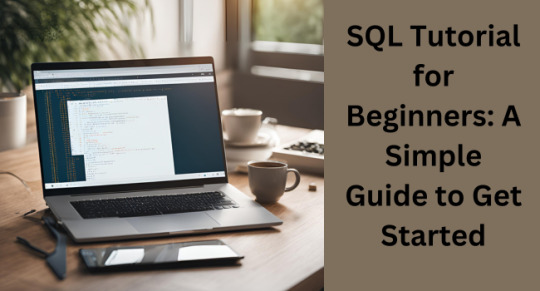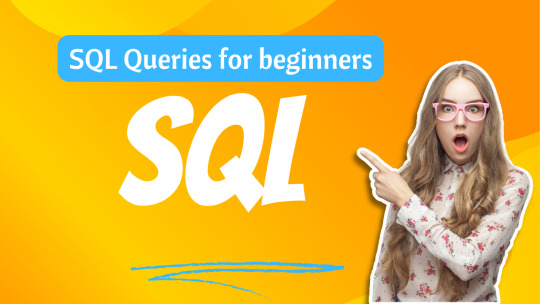#sql tutorial
Explore tagged Tumblr posts
Text
The Complete SQL Tutorial for Beginners: Learn from the Ground Up
Start your data journey with The Complete SQL Tutorial for Beginners. Learn SQL from the ground up with easy-to-follow lessons and real-world examples!
0 notes
Text
Best MySQL Tutorial for 2025: Learn Data Handling Fast
visit the blog: https://penzu.com/public/e9cf6792ab2870f1
visit more blogs:
https://www.linkedin.com/pulse/flutter-development-tutorial-create-beautiful-apps-udhav-khera-ggzdc
https://dev.to/tpointtechblog/ultimate-docker-tutorial-build-ship-and-run-apps-anywhere-168k
https://medium.com/@tpointtechblog/typescript-tutorial-you-need-in-2025-boost-your-javascript-skills-d2121643f868
https://tpointtechblog.hashnode.dev/best-power-bi-tutorial-for-2025-analyze-data-like-an-expert
https://www.patreon.com/user?u=169347449
https://tpointtechblog.blogspot.com/2025/06/next-gen-php-tutorials-learn-real-world.html
0 notes
Text
SQL Tutorial for Beginners: Learn How to Query Databases
In today’s data-driven world, almost every application, website, or business process involves data in some form. From your favorite e-commerce platform to your personal banking app, data is stored, managed, and retrieved using databases. To interact with these databases, we use a powerful language called SQL.
If you’re a beginner looking to learn how to query databases, you’re in the right place. This SQL tutorial will introduce you to the basics of SQL (Structured Query Language) and explain how you can use it to communicate with databases—no programming experience required.

What is SQL?
SQL stands for Structured Query Language. It’s the standard language used to store, retrieve, manage, and manipulate data in relational databases—databases that store data in tables, much like spreadsheets.
Think of a relational database as a collection of tables, where each table contains rows and columns. Each column has a specific type of data, like names, dates, or prices, and each row is a record (an entry) in the table.
Why Learn SQL?
SQL is one of the most in-demand skills for developers, data analysts, data scientists, and even marketers and business professionals. Here’s why learning SQL is a great idea:
Universal: It’s used by nearly every industry that deals with data.
Easy to Learn: SQL has a relatively simple and readable syntax.
Powerful: SQL allows you to ask complex questions and get exactly the data you need.
Great for Career Growth: SQL knowledge is a key skill in many tech and data-focused roles.
Core Concepts You Need to Know
Before jumping into actual queries, it’s helpful to understand some key concepts and terminology:
1. Tables
A table is a collection of data organized in rows and columns. For example, a Customers table might include columns like CustomerID, Name, Email, and Phone.
2. Rows
Each row in a table is a record. For example, one row in the Customers table could represent a single person.
3. Columns
Each column represents a specific attribute of the data. In our example, Email is a column that stores email addresses of customers.
4. Queries
A query is a question you ask the database. You use SQL to write queries and tell the database what information you want to retrieve.
Basic SQL Commands for Beginners
Here are the most commonly used SQL statements that beginners should become familiar with:
1. SELECT
The SELECT statement is used to read or retrieve data from a table. It’s the most commonly used SQL command.
Example (in simple English): "Show me all the data in the Customers table."
2. WHERE
The WHERE clause helps you filter results based on specific conditions.
Example: "Show me all customers whose country is Canada."
3. ORDER BY
You can sort the data using the ORDER BY clause.
Example: "Show customers sorted by their names in alphabetical order."
4. INSERT INTO
This command adds new records (rows) to a table.
Example: "Add a new customer named Alice with her email and phone number."
5. UPDATE
This modifies existing records in a table.
Example: "Change the phone number of customer with ID 10."
6. DELETE
This removes records from a table.
Example: "Delete the customer with ID 15."
A Real-Life Example: Online Store
Imagine you run an online store, and you have a table called Products. This table includes columns like ProductID, Name, Category, and Price.
With SQL, you could:
Find all products in the “Electronics” category.
List the top 5 most expensive products.
Update the price of a specific product.
Remove discontinued items.
SQL allows you to manage all of this with a few clear instructions.
How to Practice SQL
Learning SQL is best done by doing. Fortunately, there are many free and interactive tools you can use to practice writing SQL queries without needing to install anything:
Tpoint Tech (tpointtech.com/sql-tutorial)
W3Schools SQL Tutorial (w3schools.com/sql)
LeetCode SQL problems (great for more advanced practice)
Mode SQL Tutorial (mode.com/sql-tutorial)
These platforms let you write and test queries directly in your browser, often with real-world examples.
Final Thoughts
SQL is a foundational tool for anyone working with data. Whether you're a developer managing back-end systems, a data analyst exploring customer trends, or a marketer analyzing campaign results, knowing how to query databases will empower you to make smarter, data-driven decisions.
This beginner-friendly tutorial is just the first step. As you become more comfortable with SQL, you'll be able to write more complex queries, join multiple tables, and dive into advanced topics like subqueries and database design.
0 notes
Text
SQL Tutorial for Beginners: Essential Concepts, Queries, and Best Practices

Are you new to databases and wondering how to manage data efficiently? This SQL Tutorial for Beginners will help you easily understand the basics of SQL.
What is SQL?
SQL (Structured Query Language) is a language used to interact with databases. It helps store, retrieve, and manage data efficiently. Many companies use SQL to handle their data, making it a valuable skill to learn.
Why Should You Learn SQL?
Easy to Learn – SQL has a simple syntax, making it beginner-friendly.
High Demand – Many businesses require SQL skills for data analysis and management.
Works with Many Databases – SQL is used in MySQL, PostgreSQL, and other popular databases.
Key SQL Concepts for Beginners
Tables – Data is stored in tables, similar to spreadsheets.
Queries – Commands used to retrieve and manage data.
Filtering Data – SQL allows you to find specific information easily.
Data Modification – You can update, insert, or delete data when needed.
Start Learning SQL Today
By learning SQL, you can improve your career opportunities and work with large datasets efficiently. Start your journey with this SQL Tutorial for Beginners and enhance your database skills.
0 notes
Text

Learn SQL from scratch with this SQL tutorial for beginners. Understand databases, write queries, and manage data easily with step-by-step guidance. Perfect for beginners looking to master SQL basics!
0 notes
Text
SQL queries for beginners

0 notes
Text

SQL Interview Questions
The following SQL interview questions and answers are designed to familiarize candidates with common interview questions.
#besttraininginstitute#traininginstitute#onlinetraining#training#online#coding#tutorial#technology#trending#design#infographics#sql#mysql#database#programming#engineering
5 notes
·
View notes
Text
ssrs training
unleash the potential of data with our power bi training. join dynamic online classes and become a master in business analytics. enroll now!
ssis ssrs ssas certification , ssrs training , ssrs course , microsoft ssis certification , ssrs certification
#ssis ssrs ssas certification#ssrs training#ssrs course#microsoft ssis certification#ssrs certification#msbi certification#msbi training#power bi certification#power bi tutorial#sql server tutorial#sql server certification#msbi tutorial
2 notes
·
View notes
Text
on the one hand cypher query language feels like a headache and a half
on the other it feels so good to write a successful query :3
#don't mind me having a moment#the real cql vs sql#my coworker gave me a 10 minute cypher tutorial the other day#and then I made a little cql vs sql cheat sheet#so far it’s been working out :3
0 notes
Text
Learn SQL Fast: A Step-by-Step Tutorial for Beginners
0 notes
Text
📊 SQL Tutorial for Data Analysis and Reporting
📊 Learn SQL for effective data analysis and reporting in this comprehensive tutorial. Master key concepts like SELECT, JOIN, GROUP BY, and subqueries to extract insights from data. Whether you're a beginner or looking to enhance your skills, this guide covers everything from basic queries to advanced reporting techniques. Gain the tools to analyze datasets, build reports, and make data-driven decisions. Perfect for analysts, developers, and anyone working with databases. Start transforming raw data into meaningful insights today!
visit the blog: https://tpointtechblog.hashnode.dev/sql-tutorial-for-data-analysis-and-reporting
0 notes
Text
SQL Tutorial | Tpoint Tech
Master SQL with this step-by-step tutorial, perfect for beginners and professionals. Learn how to write queries, manage databases, and analyze data using real-world examples. Cover key topics like SELECT, JOIN, WHERE, and GROUP BY. Build your data skills with practical exercises and clear explanations. Start your SQL journey and unlock the power of relational databases
0 notes
